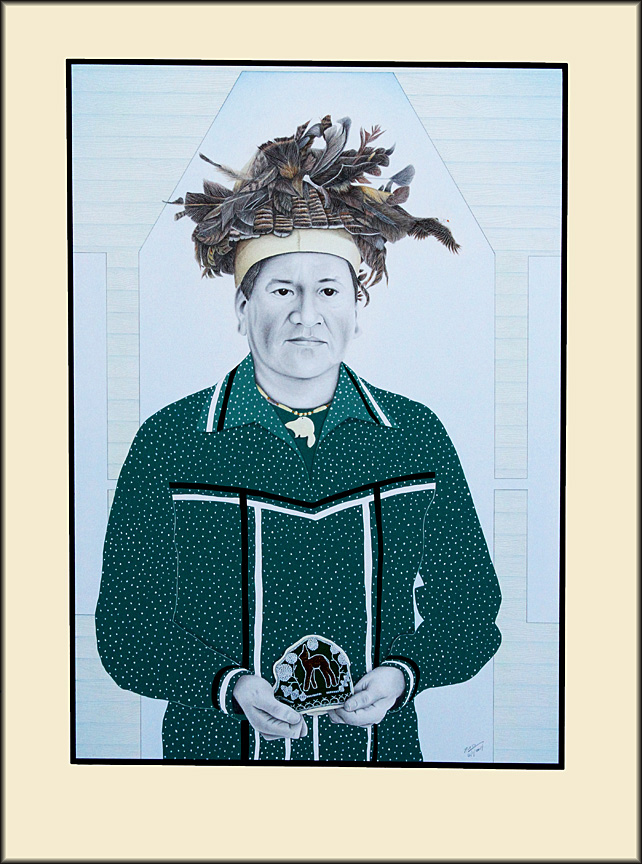Bryan has been doing beadwork since he was 12 years old. His mother sold her beadwork on the powwow circuit and Bryan often accompanied her where he sold pieces that he created. “I would have to crank out a lot of work every weekend,” says Bryan, “which was great for me because it gave me pocket cash when I was a teenager.” Being a perfectionist has made designing pieces a gratifying challenge for Bryan because he approached each example as a unique piece of art. Working this way has carried him through all his years as a Tuscarora artist and has guided him to never make two pieces exactly alike. When he transitioned to raised beadwork in 2005, he continued to produce beautiful, one-of-a-kind pieces of beadwork.
“Before I went to college” says Bryan, “I thought I knew who I was, and what I identified with, but I was wrong.” Most of the people he encountered at his university had never seen an Indian or been in contact with one. “I had to truly understand myself so I could represent Native people as best I could. This is when I realized I didn't fully understand what it meant to be Native or Tuscarora. This lack of self-understanding motivated me to learn about myself and my culture. My school's propensity towards classical architecture still inspires the work I do today (i.e. beadwork, design work with both my job and the new facility at Tuscarora). Classical design, proportions, structure, color, and shapes are all part of my world today.” Bryan works for the environment office on the Tuscarora Nation and often finds inspiration for his beadwork in the natural world around him.
Since he started doing raised beadwork, Bryan says he had to apply himself “to understand the medium and figure out how it will represent me, and how I would stay true to the Tuscarora style of beadwork.” Because beadwork is an honored and enduring tradition among the Tuscarora, he wanted to make sure that he was “doing it justice. As I make each piece I learn a bit more about Haudenosaunee culture, Tuscarora identity and our relationship with nature.”
Bryan says Tuscarora beadworkers “have a responsibility to preserve their culture and remind people that we are not reviving an ancient art form, or reintroducing it, but continuing it into today.” A question often heard when exhibiting their beadwork is that people were unaware that this kind of work was still being produced. “We have to remind them that it didn't go anywhere,” says Bryan. “Tuscarora raised beadwork has always been part of our community. Beadwork is a great storyteller that expresses our people's relationship to each other; it also speaks to our relationship with nature, other communities, and to our traditions.”
As an architect, Bryan had a small part in the design of the new Nation House on the Tuscarora Nation. Although not officially on the design committee, he acted as the liaison between the architectural firm and the Nation council overseeing the design.
Architecture has long been his passion so I thought it would be fitting to feature one of the design concepts for the Nation House into his portrait. The building plan incorporated a stylized version of the Hiawatha wampum belt in the design of the windows so I added this as a detail to the background of his portrait. The wampum belt symbolizes the agreement between the five original Haudenosaunee Nations promising to live in unity and stand by one another in times of trouble.
In the portrait, Bryan is also holding a baby’s crown that he made for his niece. “I used an exaggerated Victorian shape for the crown,” says Bryan, set against “a contemporary deer design (her clan) and Haudenosaunee iconography. I like the juxtaposition of something overtly Victorian with something modern like color schemes, subject matter or beadwork composition. So I modeled the deer off of Bambi and I used the sky dome design around the base of the crown. I wanted it to reflect her age but still keeping with the maturity of a crown and the rest of her outfit. I made this in 2009, when she was a year old.”
In 2013 Bryan participated in the Tuscarora Migration Project, a 1,300 mile, 70-day odyssey retracing the migration north of the Tuscarora from their original home in North Carolina in the early 1700s. The participants hiked through six states from Fort Nooherooka, Snow Hill, NC to the Tuscarora Nation, Lewiston, NY. Bryan also co-authored the book Images of America - Tuscarora Nation, NY (Arcadia Publishing) in 2007.
